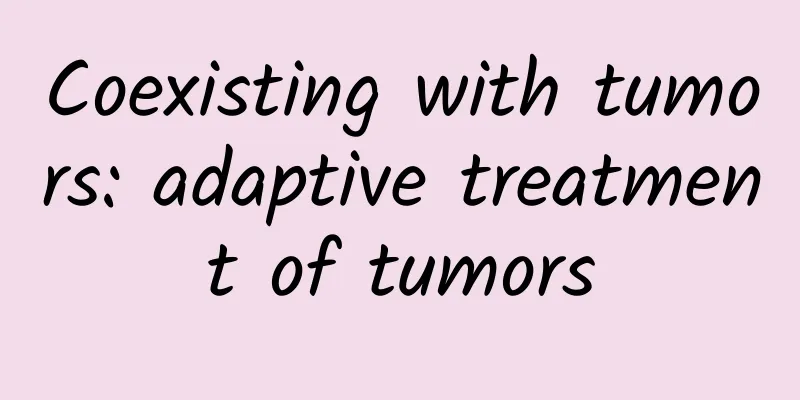Coexisting with tumors: adaptive treatment of tumors

|
Author: Chu Juhang Shanghai Tenth People's Hospital Qian Mingping Shanghai Tenth People's Hospital Reviewer: Li Jun, Chief Physician, Shanghai Tenth People's Hospital In recent years, with the development of medical technology, the early diagnosis rate of cancer has been significantly improved, the treatment effect has been significantly improved, and the prognosis of patients has been significantly improved. Although we cannot completely conquer cancer, "cancer = death" has gradually become a thing of the past. Cancer is classified as a chronic disease. We need to establish a mindset of treating chronic diseases and find ways to slow down the progression of cancer so that it can be controlled like diabetes and hypertension. This is adaptive treatment of tumors. Today we will learn about adaptive treatment of tumors and understand how to "coexist with tumors." Tumor tolerance makes it a little difficult to eliminate tumors At present, the main methods for treating cancer include surgery, radiotherapy, chemotherapy, targeted therapy and immunotherapy, etc. These treatments follow the maximum tolerated dose model, in other words, the maximum dose is used within the maximum range allowed by the patient's physical condition to achieve the maximum killing of the tumor. With the development of single-cell sequencing technology, people have realized that each cancer cell may be different, just as there are no two leaves in the world that are exactly the same, so the sensitivity to therapeutic drugs will also vary from cell to cell. Tumor cells are very cunning and know how to survive the carpet bombardment of therapeutic drugs. As the number of treatments increases, tumor cells will become more and more "difficult to kill", which is professionally called tumor resistance. The mechanisms of tumor drug resistance mainly include: on the one hand, large doses of drugs break the original balance between sensitive tumor cells and drug-resistant cell subpopulations, resulting in a decrease in the number of sensitive cells as the treatment progresses, and drug-resistant cells take this opportunity to increase wildly and take the initiative; on the other hand, under the selective pressure of drugs, some cells that were originally sensitive to drugs become drug-resistant cells. This is why many advanced cancer treatments can effectively kill tumor cells at the beginning of treatment, but will soon develop into irreversible drug resistance, accompanied by a rapid deterioration of the patient's condition. Faced with this dilemma, most clinicians would choose to replace the drug that has been tolerated with other drugs. However, tumor cells will soon repeat the above process and become resistant to the new drug. This cycle repeats itself, and it becomes difficult to eliminate all tumor remnants. Adaptive therapy to achieve coexistence with tumors Adaptive therapy refers to adjusting drugs according to the competitive relationship between drug-sensitive cells and drug-resistant cells and the development of tumors, retaining some sensitive cells to maintain their competitive advantage. At this time, the optimal therapeutic dose is no longer the maximum therapeutic dose, but the necessary minimum dose. Once the tumor shrinks to the ideal size, treatment is stopped or maintained to ensure the advantage of sensitive cells. Some friends may wonder if leaving the tumor behind will lead to tumor progression? It is normal to have such doubts, so when using adaptive therapy, it is necessary to closely monitor the tumor, such as regularly testing tumor markers and imaging examinations, and once the tumor is found to have a tendency to progress, timely drug treatment should be given. Figure 1 Copyright image, no permission to reprint Retreat to advance, and reap unexpected surprises For some slowly progressing, less malignant tumors, such as prostate cancer, certain types of thyroid cancer, or lymphoma, doctors may choose an adaptive treatment strategy. It should be emphasized that coexistence with tumors does not mean giving up treatment, but rather shifting the goal of treatment from cure to control, and from prolonging life to improving the quality of life. Doctors will develop individualized treatment plans based on the patient's specific circumstances to maximize the patient's survival time and help them stay as comfortable and dignified as possible. The ultimate goal is to allow patients to resume daily activities and enjoy life as much as possible while coexisting with the tumor, rather than focusing solely on the size and number of the tumor. Self-management of living with tumor 1. Dietary adjustment: Eat a balanced diet and increase the intake of foods rich in vitamins, minerals and antioxidants, such as fresh fruits and vegetables, whole grains, lean meat and soy products. 2. Moderate exercise: Engage in appropriate physical activities according to the doctor's advice, such as walking, yoga, Tai Chi, etc., which will help improve physical fitness and enhance immunity. 3. Regular review: Regular review to monitor changes in the condition so as to adjust the treatment plan in time. 4. Follow doctor's orders: Patients should strictly follow the doctor's prescriptions and treatment instructions, take medications on time, and should not increase or decrease the dosage or stop taking medications at will. Figure 2 Copyright image, no permission to reprint For cancer patients, whether to choose traditional treatment or adaptive treatment, clinicians and patients must weigh the pros and cons and make a proper choice. No matter which treatment method is used, it should emphasize the self-management of cancer patients, maintain a positive attitude towards treatment, and face cancer optimistically! |
<<: Ultraviolet Survival for Hair and Scalp
>>: Tear off prejudice and correctly understand cerebral palsy from the movie "Little Me"
Recommend
Can chrysanthemum tea remove bad breath? What is the best tea to drink to remove bad breath?
Scented tea is common in life, especially chrysan...
Vaginal tightening exercises and training methods after normal delivery
In life, many women choose cesarean section to pr...
Autism = self-isolation? Autism = genius? Don’t misunderstand these “children from the stars” anymore!
"Autism = self-isolation? Autism = genius?&q...
How can a mother quickly expel lochia?
After a woman gives birth, the placenta will slow...
Slight bleeding during pregnancy
The first month of pregnancy is the most dangerou...
What should women do if they have hemorrhoids?
It used to be said that "nine out of ten men...
What is the reason for clear water in the nipples when I am six months pregnant?
Pregnant women need to do many things that are be...
Is it harmful to the body to remove the gauze during cervical biopsy?
Nowadays, medicine is developing very rapidly. Fo...
Why does the vagina hurt?
Many women who do not pay attention to their phys...
Why does black blood come out of the vagina?
Women's health is an issue that people are co...
Taking medicine without drinking water? Swallowing pills dry is harmful!
In daily life, headaches and fever are common, an...
What's the matter with the fleshy thing at the vulva?
The female vaginal tissue is very special. The va...
Areola with fleshy grains
The female breast is a very important sexual orga...
Is cupping good for confinement?
Giving birth to a child is extremely physically d...
The reason why the first fetus vomits but the second fetus does not
Women should be the happiest during this stage of...









